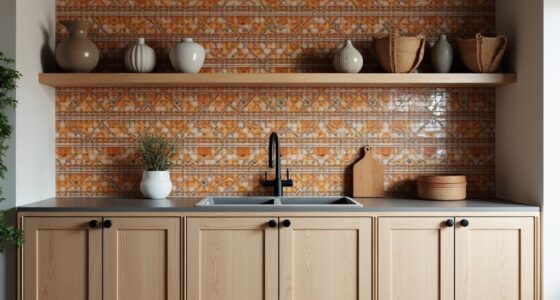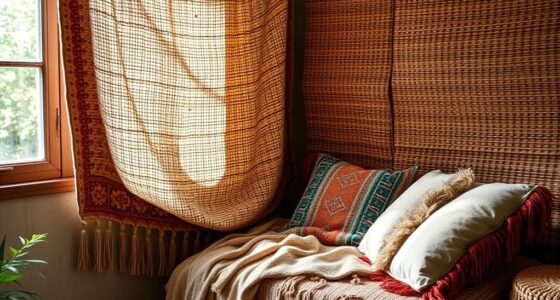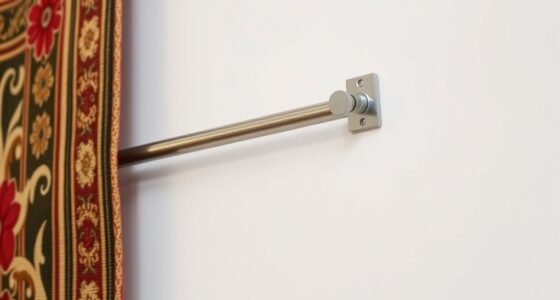To achieve a cozy boho chic look with layered rugs, start by choosing a large base rug that extends beyond your furniture edges. Add smaller rugs on top, mixing textures and patterns while keeping colors cohesive or complementary. Focus on proportional sizes and arrange rugs to define zones and create visual interest. Keep clutter minimal and guarantee all rugs are secured with padding. If you want to master the art of layering, there’s more to discover below.
Key Takeaways
- Start with a large, neutral base rug to anchor the space and set a cohesive foundation.
- Layer smaller rugs with varied textures, patterns, and shades to add visual interest and depth.
- Ensure all rugs are proportionate to furniture and room size for balanced layering.
- Use a consistent color palette or complementary hues to create harmony and a cohesive boho aesthetic.
- Place rug padding beneath all layers to prevent slipping and maintain a polished, cozy look.
Understanding the Benefits of Layered Rugs in Your Space
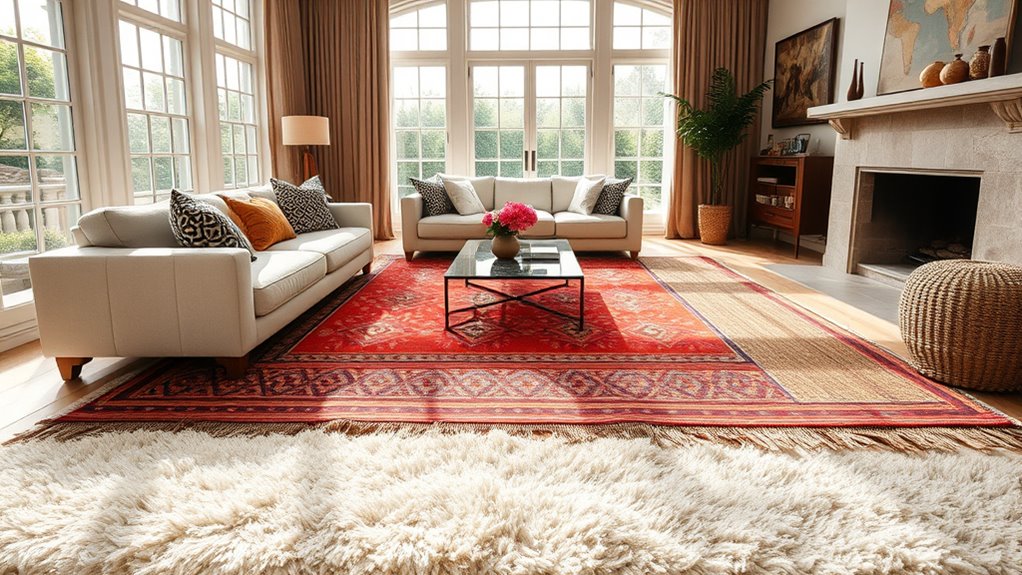
Layered rugs can instantly elevate your space by adding texture, depth, and visual interest. Proper rug placement creates a layered look that feels intentional and stylish. By carefully overlapping rugs of different textures, you introduce contrast that makes your room more dynamic. This visual contrast highlights individual pieces while tying the space together. Layering also helps define specific areas, making open-concept rooms feel cozier and more structured. Plus, it’s a flexible design strategy—you can easily swap out rugs to change your decor vibe. The key is to balance the placement so that each rug complements the others without cluttering the space. Overall, layered rugs are a simple way to add dimension and personality, making your room feel more inviting and thoughtfully designed. Incorporating rug layering techniques can further enhance your decor’s cohesiveness and style, especially when considering layering best practices for a polished look.
Selecting the Perfect Rug Sizes for Layering
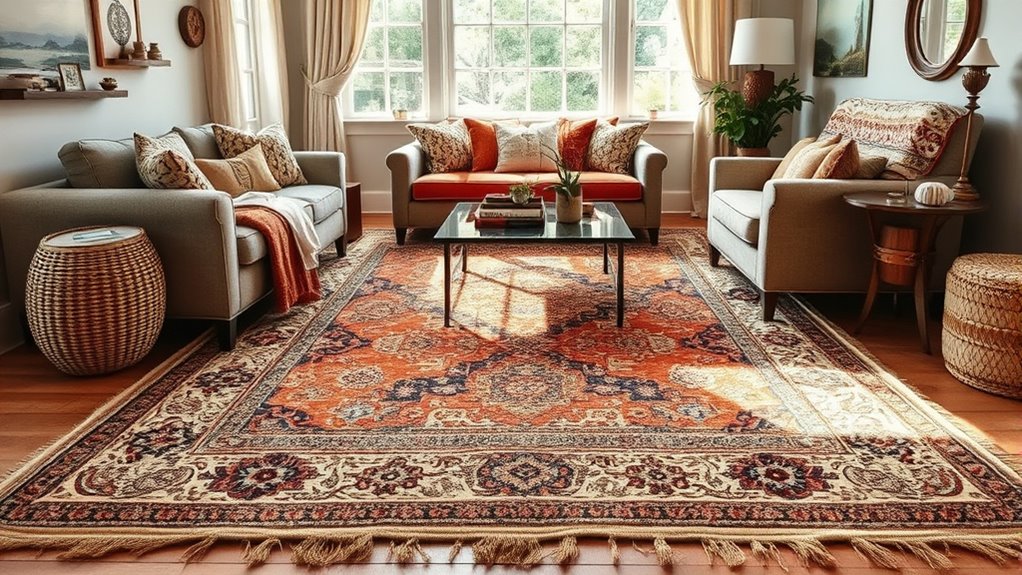
Choosing the right rug sizes is key to creating a balanced layered look. You’ll want to contemplate your room’s size and how different rug dimensions work together. By focusing on proportion and layering techniques, you can achieve a cohesive and stylish space. Additionally, considering the size of the furniture and placement will help ensure the layered rugs complement your farmhouse aesthetic and create a harmonious environment. Understanding rug layering techniques can further enhance the visual appeal and comfort of your space. Paying attention to drainage and moisture in the area can also help maintain the integrity of your layered rugs over time.
Balance and Proportion
Have you ever wondered how to create a harmonious layered rug display? Achieving balance and proportion is key. First, choose rug sizes that complement each other—start with a larger rug as a base, then layer smaller ones on top. Second, consider color contrast; mixing textures and shades adds visual interest without overwhelming the space. Third, pay attention to material mixing—combine soft, plush rugs with flat-woven ones for variety. Fourth, guarantee the rugs are proportionate to your furniture and room size so everything feels cohesive. Additionally, selecting appropriate rug materials can influence the overall texture and durability of your layered arrangement. To ensure a seamless look, it’s helpful to understand how asset division principles can guide you in balancing different elements effectively. Avoid overwhelming the space with too many small rugs or mismatched sizes. By thoughtfully selecting rug sizes and balancing color contrast and material, you’ll craft a layered look that’s both cozy and visually appealing.
Room Size Considerations
When selecting rug sizes for layering, considering your room’s dimensions is essential to creating a balanced and inviting space. Larger rooms can handle bigger area rug selections, allowing you to layer multiple rugs without feeling cramped. In smaller spaces, opt for smaller or proportionate rug sizes to avoid overwhelming the area. Be mindful of how the rugs interact with your furniture; rugs should complement, not clutter. Proper rug sizing ensures a cohesive look and helps define different zones within the room. Also, keep in mind rug cleaning tips—smaller rugs are easier to maintain and clean, making layered rugs practical. Color theory principles can guide your choices to create harmonious and visually appealing layered rug arrangements. Additionally, considering space utilization helps in choosing rug sizes that maximize comfort and functionality. Selecting the right rug sizes also involves understanding educational toy safety, ensuring your layered rugs are placed in safe and child-friendly areas. By choosing the right sizes based on your room’s size, you’ll achieve a cozy, layered boho chic look that feels both stylish and comfortable.
Layering Techniques
To master layering rugs effectively, selecting the right sizes for each piece is essential. Start with a large area rug as the foundation, ensuring it covers enough space and creates a cozy base. Then, choose smaller rugs to layer on top, adding texture and visual interest. When layering, consider these size guidelines:
- Use a sizable area rug that extends beyond furniture, anchoring the space.
- Opt for smaller rugs that fit within the larger rug’s boundaries, creating contrast.
- Incorporate varying shapes and sizes for a dynamic look.
- Always add rug padding beneath each layer to prevent slipping and protect your flooring.
- Pay attention to the rug materials and their durability to ensure your layered setup remains stylish and functional over time, especially as different textures can influence the overall energy and ambiance of your space. Additionally, understanding industry trends can help you choose rugs that stay fashionable and enhance the aesthetic appeal.
Choosing Patterns and Textures to Enhance Your Boho Style
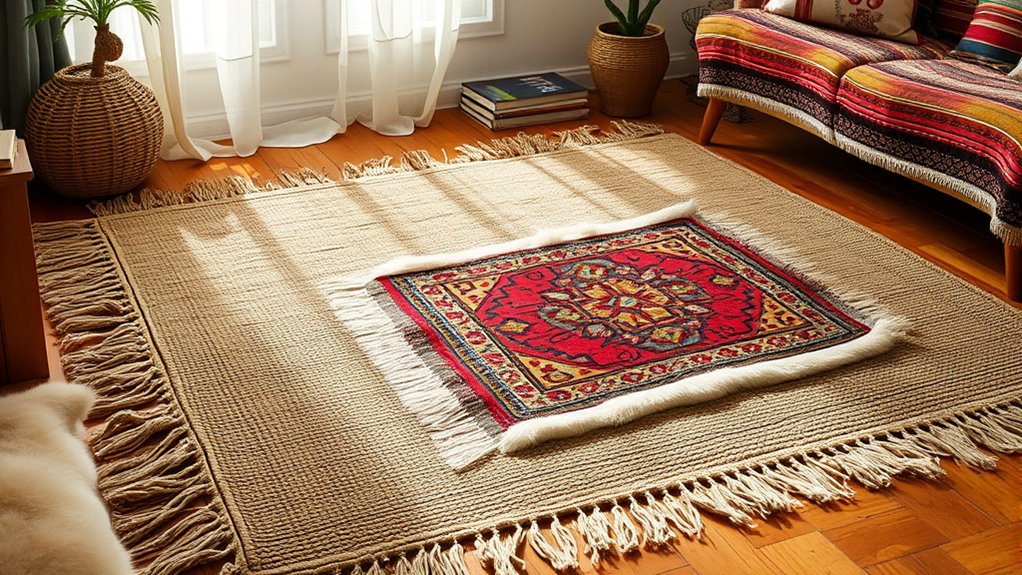
Choosing the right patterns and textures is key to elevating your boho style with layered rugs. Focus on color combinations that complement each other, creating a harmonious yet lively look. Mix bold, vibrant patterns with more subdued designs to add visual interest without overwhelming the space. Texture contrast is equally important—pair plush, shaggy rugs with flatter woven pieces to add depth and tactile variety. Combining different textures keeps your layered arrangement dynamic and inviting. Incorporating emotional intelligence into your design choices can help you better understand how different textures and patterns evoke comfort and personality in your space. Understanding the role of attention in your creative process allows you to select and arrange your rugs thoughtfully, enhancing the overall aesthetic. Don’t shy away from mixing geometric with organic patterns; the contrast enhances the boho vibe. Keep in mind that balance is essential, so select patterns and textures that work together to create a cozy, curated look. Ultimately, thoughtful pattern and texture choices will make your layered rugs truly stand out.
Tips for Mixing and Matching Rug Colors
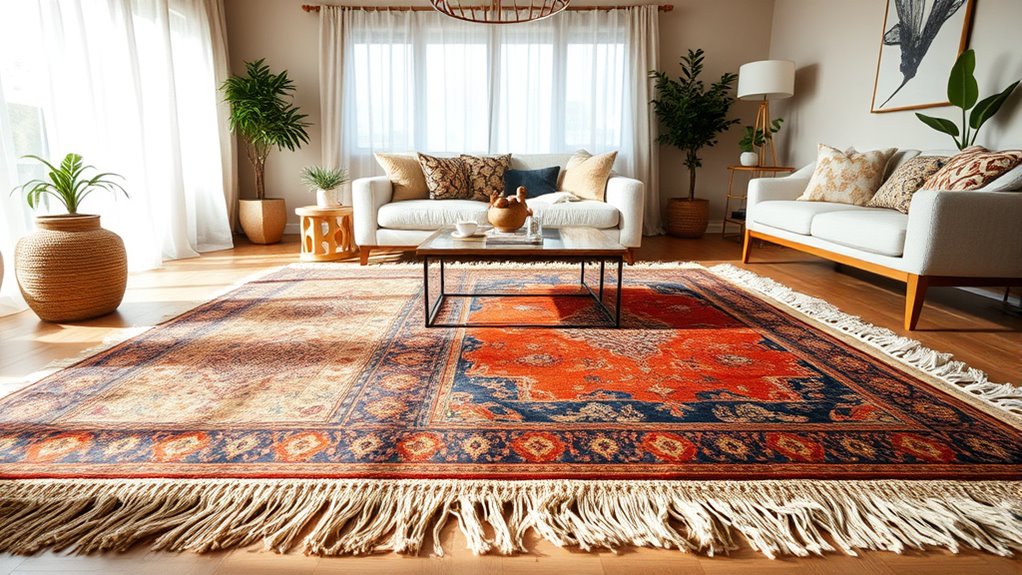
Mixing and matching rug colors can transform your space into a vibrant, cohesive retreat. To achieve this, focus on color harmony and pattern coordination. Here are some tips:
- Stick to a color palette with 2-3 main hues to keep the look unified.
- Use complementary colors to create visual interest without clashing.
- Mix patterns with varying scales, ensuring they share a common color or tone.
- Incorporate neutral tones to balance bold colors and prevent overstimulation.
- Consider the influence of sound healing science to choose calming and harmonious color combinations that promote relaxation. Additionally, understanding the rhythms and frequencies associated with different colors can enhance the overall sensory experience in your space.
Arranging Rugs for a Cohesive and Inviting Look
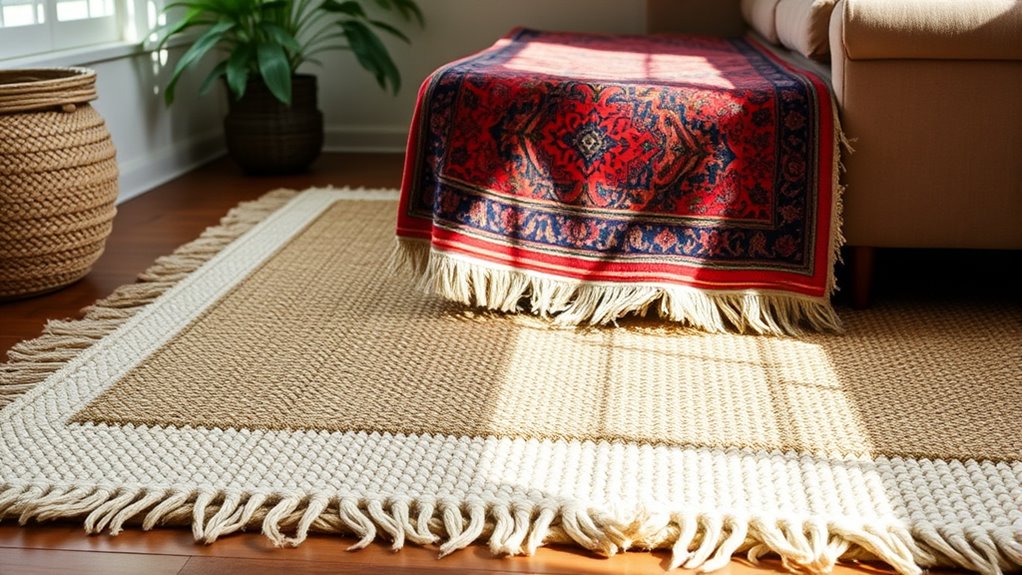
To create a cohesive and inviting layered rug arrangement, start by balancing rug sizes so they complement each other without overwhelming the space. Make sure your patterns align smoothly to avoid visual clutter, and use rugs to clearly define different zones within the room. With these tips, your layered look will feel intentional and welcoming. Additionally, considering rug materials can enhance comfort and durability, ensuring your layered setup remains stylish and practical over time. Incorporating sound design techniques like layering and spatial effects can also help achieve a harmonious visual balance in your decor.
Balance Rug Sizes
Balancing rug sizes is key to creating a cohesive and inviting space. When layering area rugs, choose sizes that complement each other and the room layout. Here are some tips:
- Use a larger rug as a base, ensuring it extends beyond furniture edges for comfort.
- Layer smaller rugs on top, placing them strategically to highlight specific zones.
- Add rug padding beneath smaller rugs to prevent slipping and maintain balance.
- Vary the rug sizes but keep proportions harmonious, avoiding overwhelming or tiny layers.
- Consider visual balance when arranging layered rugs to enhance overall harmony and style. Incorporating principles of interior design can further elevate the layered look and ensure a well-balanced aesthetic.
- Paying attention to rug placement can help create a more cohesive and aesthetically pleasing layered rug arrangement.
Align Patterns Seamlessly
Aligning patterns when layering rugs guarantees your space feels cohesive and inviting. Focus on geometric shapes to create visual harmony; for example, pair a patterned rug with angular designs alongside a more subdued, solid piece. Use color coordination to tie different patterns together—stick to a shared palette or complementary hues that enhance the overall look. Keep the patterns in the same style or tone, avoiding clashes that can make the space feel chaotic. If one rug features bold geometric shapes, balance it with subtler, coordinating patterns nearby. This approach ensures the layered rugs complement each other rather than compete, making your space feel thoughtfully curated and cozy. Seamless pattern alignment is key to achieving that effortless boho chic vibe. Additionally, understanding credit card insights can help you budget for home decor projects responsibly.
Define Spaces Clearly
Arranging rugs thoughtfully helps define different areas within a room, making your space feel both cohesive and inviting. To clearly specify each zone, consider these strategies:
- Use large area rugs to anchor main seating or dining areas, creating visual boundaries.
- Layer smaller rugs over larger ones, adding texture and delineating different sections.
- Place rug padding underneath all area rugs to prevent slipping and protect your floors.
- Make certain rugs extend beyond furniture edges enough to frame each space without crowding.
Incorporating Layered Rugs in Different Rooms
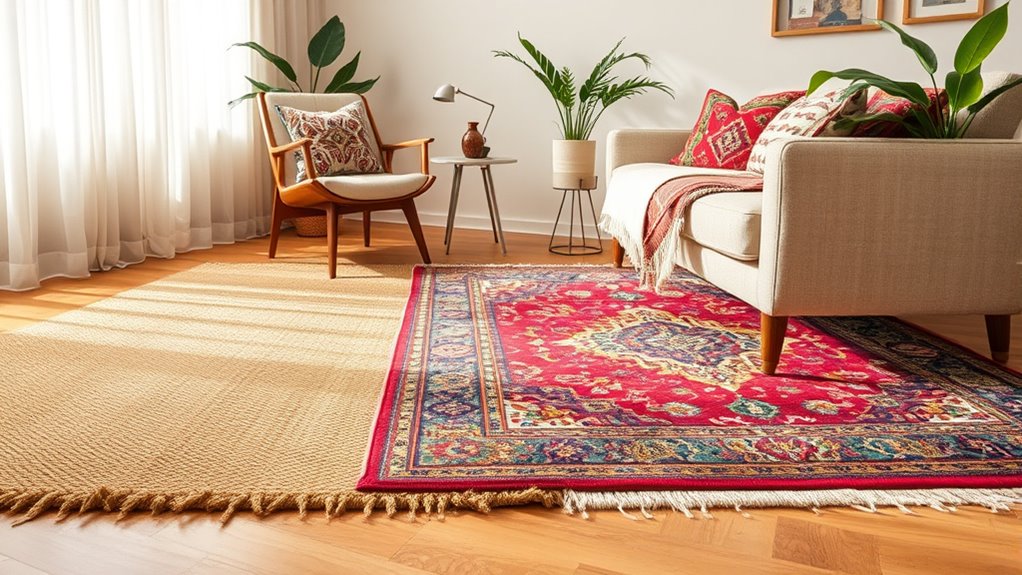
Incorporating layered rugs into different rooms can instantly add depth and personality to your space. When choosing rug materials, consider textures that complement each other—for example, pairing a soft wool rug with a jute or sisal piece creates visual interest and tactile variety. Color coordination is key; select rugs that harmonize with your room’s palette or intentionally contrast for a bold statement. In living rooms, layer a patterned rug over a neutral base to anchor the seating area. In bedrooms, combine a plush rug with a flatter weave for comfort and style. Keep in mind the overall vibe of each space to guarantee your layered rugs enhance rather than clutter. With thoughtful material and color choices, you’ll create inviting, cohesive rooms that feel cozy and curated.
Using Rugs as Focal Points and Accents
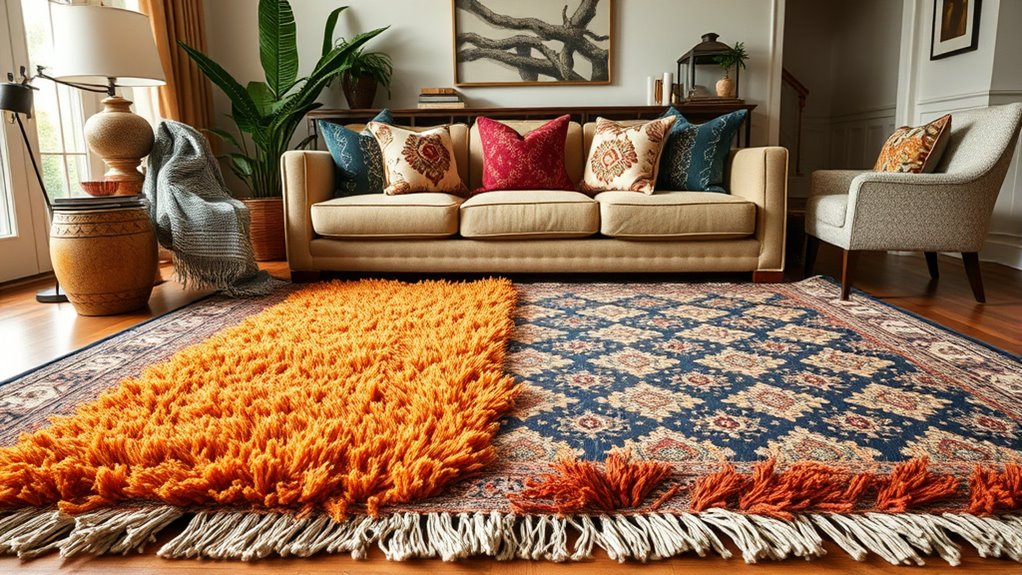
Layered rugs don’t just add texture and warmth; they also serve as striking focal points and eye-catching accents within a room. Using area rugs strategically can highlight specific areas or furniture pieces. To create impactful focal points and accents, consider these ideas:
- Place a bold, patterned rug under your coffee table to draw attention.
- Layer a smaller, textured rug over a larger neutral one to add depth.
- Use a vibrant, boho-inspired area rug to anchor a seating area.
- Position layered rugs near entryways to create inviting, stylish focal points.
Maintenance and Care Tips for Layered Rugs
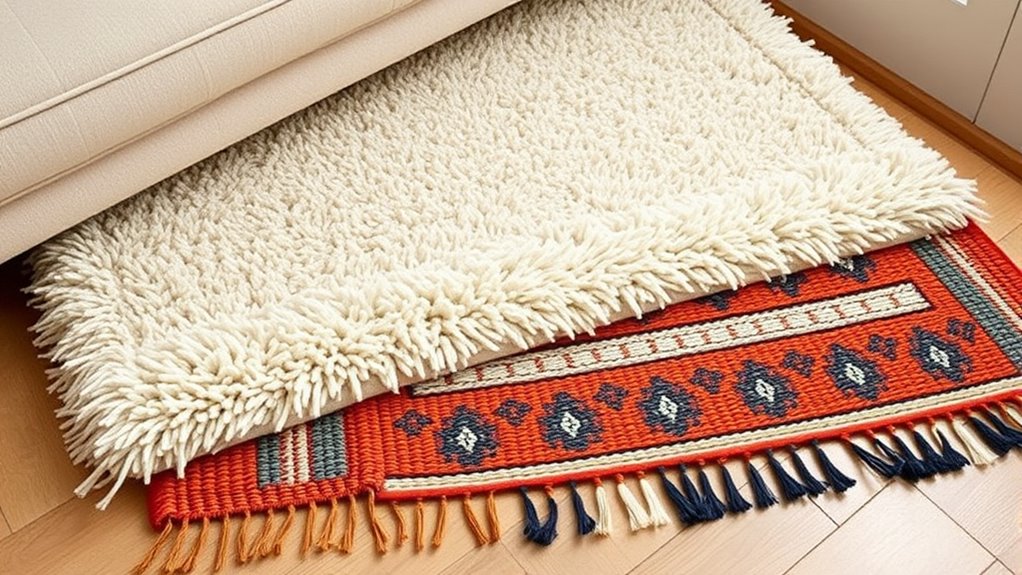
Maintaining and caring for layered rugs requires regular attention to keep them looking their best. Start by vacuum maintenance, ensuring you gently vacuum each layer without disturbing their arrangement. Use a vacuum with a brushless attachment or set it to a low suction setting to prevent damage. This helps remove dust, dirt, and debris that can accumulate between layers. When stains occur, act quickly with stain removal. Blot spills immediately with a clean, damp cloth—avoid rubbing, which can push stains deeper. For stubborn stains, use a gentle rug cleaner suited to the material, testing it first on a small area. Regular care keeps your layered rugs fresh, vibrant, and cozy, preserving their boho chic appeal for years to come.
Creative Ideas for Layering Rugs on Carpeting and Hard Floors

Mixing textures and patterns adds visual interest and depth to your layered rugs. Experiment with different rug sizes to create a balanced and inviting look. Don’t be afraid to combine bold designs with subtle tones for a stylish, personalized space.
Mixing Textures and Patterns
When you combine different textures and patterns in rug layering, you create a dynamic and inviting space that reflects your personal style. Mixing fiber textures adds depth—think plush wool with flatweave jutes or shaggy rugs with sleek synthetics. Pattern mixing keeps things lively, but focus on color coordination to avoid chaos. Here are some ideas:
- Pair a neutral, textured jute rug with a bold, patterned kilim for contrast.
- Layer a soft, shaggy rug over a flatwoven base to add tactile interest.
- Use subtle patterns in similar colors for a harmonious look.
- Combine different fiber textures, like silk and cotton, for a luxurious feel.
This approach keeps your space lively yet cohesive, showcasing your unique taste.
Using Different Rug Sizes
Layering rugs of different sizes can instantly elevate your space by adding visual interest and defining areas. To achieve a balanced look, consider rug size ratios; a common approach is to pair larger rugs as the base with smaller ones layered on top. This creates layered rug symmetry that feels intentional and cohesive. For example, place a big, plush rug under your seating area, then add a smaller, textured rug on top to highlight a specific spot or introduce pattern. Keep proportions in mind—smaller rugs should complement the larger one without overwhelming it. By thoughtfully selecting rug sizes and maintaining layered rug symmetry, you’ll create a cozy, visually appealing space that feels curated and inviting.
Common Mistakes to Avoid When Layering Rugs

Even though layering rugs can add depth and style to a space, it’s easy to make mistakes that disrupt the overall look. One common mistake is ignoring rug material choices, which can lead to uneven wear or mismatched textures. Another pitfall is creating clutter with too many layers or mismatched sizes. Additionally, neglecting rug layering pitfalls like inconsistent pile heights can make the arrangement look uneven. Finally, avoid placing rugs without considering the overall color scheme and pattern coordination, as clashing designs can detract from your boho chic vibe. To avoid these issues, choose complementary rug materials, keep layering simple, ensure even pile heights, and coordinate patterns for a cohesive, stylish look.
Frequently Asked Questions
How Do I Prevent Rugs From Slipping When Layered?
To prevent rugs from slipping when layered, you should use non-slip pads or rug grippers underneath each rug. These products provide extra grip and keep your layered rugs securely in place. Make sure to choose the right size for each rug and press them firmly onto the pads or grippers. Regularly check and adjust as needed, especially in high-traffic areas, to maintain safety and keep your layered look cozy and chic.
Can Layered Rugs Work in Small or Narrow Spaces?
Layered rugs can work in small or narrow spaces if you consider size constraints and visual balance. Opt for smaller, proportionate rugs that don’t overwhelm the area, and layer them carefully to add texture without clutter. Keep the layering simple, using just two or three rugs, so the space feels cozy rather than cramped. This approach enhances the room’s aesthetic while maintaining functionality and comfort.
What Are Budget-Friendly Options for Layering Rugs?
Imagine it’s 1999, and you’re hunting for budget-friendly options to layer rugs. You can mix and match affordable rugs from thrift stores, discount outlets, or online sales. Use rug layering tips like placing smaller rugs over larger ones or contrasting textures for interest. You don’t need pricey pieces—just get creative, play with patterns, and focus on cohesion to achieve a cozy, stylish layered look without breaking the bank.
How Do I Clean Layered Rugs Without Damaging Them?
When cleaning layered rugs, prioritize gentle rug maintenance to avoid damage. Use a vacuum with a brush attachment on a low setting, and spot clean stains promptly with a mild detergent and water. Test any stain removal method on a small hidden area first. Avoid harsh chemicals or excessive moisture, which can harm underlying layers. This careful approach keeps your layered rugs looking fresh and vibrant without risking damage.
Are There Specific Rug Materials Best Suited for Layering?
When choosing rug fiber types for layering, opt for sturdy, natural fibers like wool or jute, which hold up well under layering patterns. Avoid delicate materials like silk that may get damaged easily. Consider how different textures complement each other, creating visual interest. You want rug materials that are durable and easy to clean, ensuring your layered look stays cozy and chic without sacrificing practicality.
Conclusion
Think of layering rugs like weaving a story in your space—each piece adds depth, character, and warmth. When done thoughtfully, your room becomes a cozy tapestry inviting everyone in. Embrace the process, experiment with textures and patterns, and let your style unfold naturally. Ultimately, your layered rugs are a reflection of your unique journey—an artful expression of comfort and creativity woven into every corner of your home.


